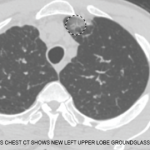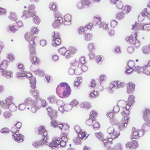At both weeks 36 and 48, equal proportions of patients in both groups achieved the primary end point (59.2% vs. 56.5%). At weeks 48 to 52, patients in the benralizumab group were more likely to have successfully tapered off of glucocorticoid therapy (41.4% vs. 25.8%) and had fewer serious adverse events (5.7% vs. 12.9%). However, 30% of patients in both groups experienced disease relapse.
The MANDARA study provides further evidence that the IL-5 blockade is an effective strategy for the treatment of EGPA. Mechanistically, benralizumab is more efficient at eliminating eosinophils, which may explain why patients treated with benralizumab were more likely to achieve a glucocorticoid-free remission. Notably, the benralizumab regimen used in this study differs from the regimen used for the treatment of severe eosinophilic asthma, which redoses patients every eight weeks. However, abstract 0678 (“Benralizuamb in eosinophilic granulomatosis with polyangiitis”) suggests the regimen used for patients with asthma may be equally effective for patients with EGPA.12
9. Remission-Induction Regimens for EGPA
Abstract 0854: Dutertre et al.13
The 2021 ACR/Vasculitis Foundation guideline for the management of ANCA-associated vasculitis recommends either rituximab or cyclophosphamide for remission induction of patients with active, severe eosinophilic granulomatosis with polyangiitis.14
Rituximab in Eosinophilic Granulomatosis with Polyangiitis (REOVAS) was a phase 3, double-blind trial that randomized 105 patients with newly diagnosed or relapsing EGPA to treatment with rituximab (1 gram pulses two weeks apart) or cyclophosphamide (nine intravenous pulses over five months).15 At the end of 180 days, remission was achieved in equal numbers of patients in both arms (63.5% vs. 60.4%), and had comparable rates of both relapse and major relapse. At the end of 360 days, remission rates in both arms remained comparable (59.6% vs. 64.2%).
In Abstract 0854, the authors present long-term follow-up from patients enrolled in REOVAS, who were followed for a median of 45 months. Only one patient was lost to follow-up.
After 45 months, the minor and major relapse-free survival rate was higher among patients treated with rituximab, but the difference between the two groups was not statistically significant (63.5% vs. 50.9%, P=0.24). However, the difference became statistically significant when the analysis included only patients who were MPO-ANCA positive (92% vs. 50%, P=0.02)
Several groups have previously demonstrated that the clinical manifestations of EGPA are influenced by ANCA status. Patients who are ANCA positive tend to have more manifestations traditionally linked to vasculitis, such as mononeuritis multiplex. In patients who are ANCA negative, the eosinophilic manifestations tend to dominate. Given that rituximab directly impacts B cell function, it seems rational that rituximab would be more effective among patients whose disease is characterized by ANCA production.



